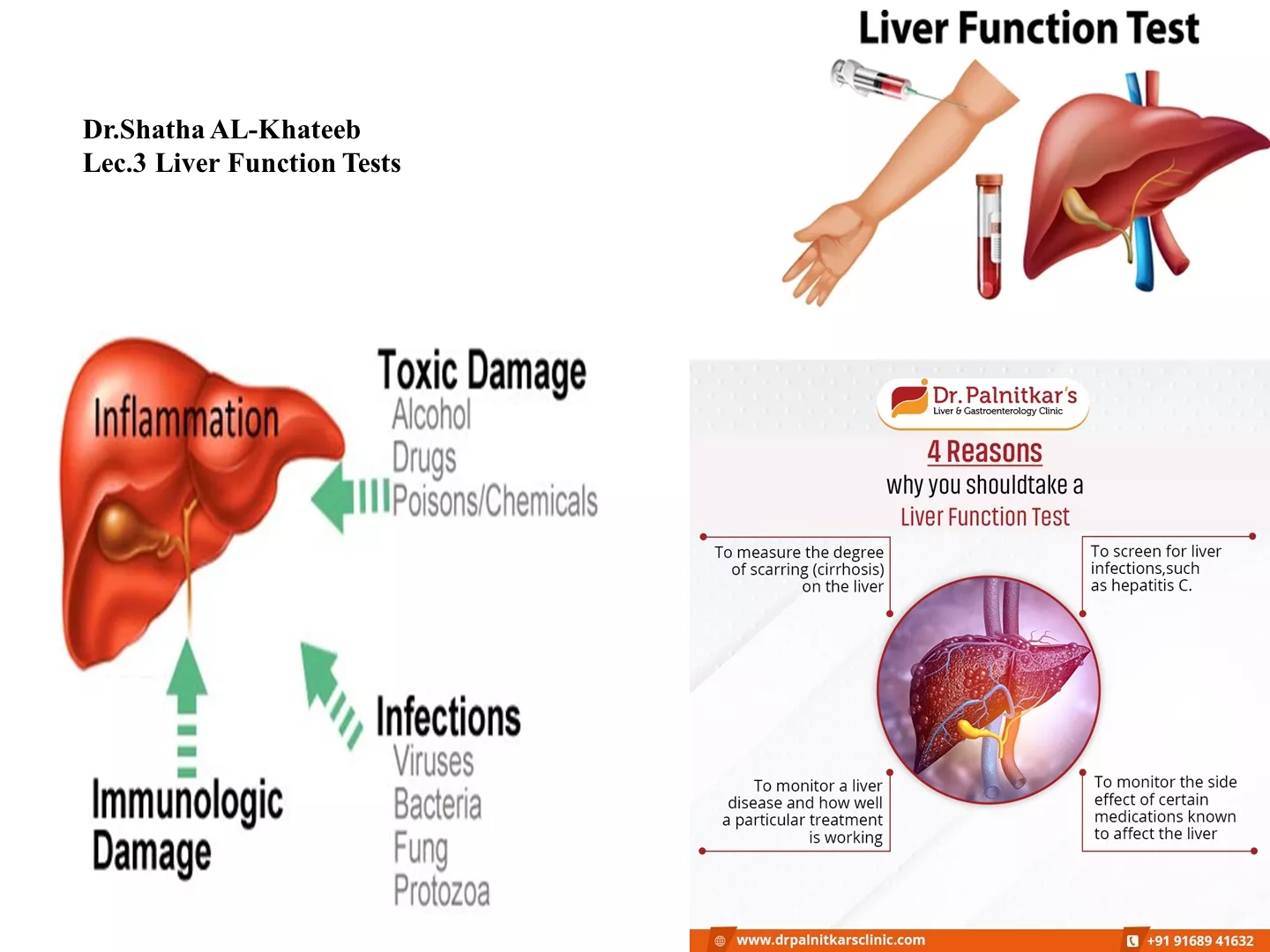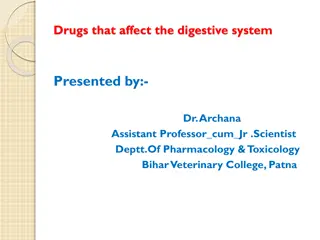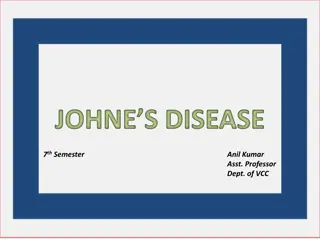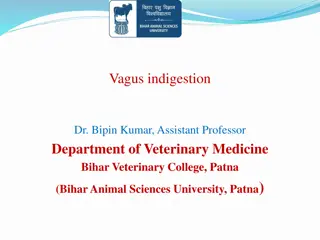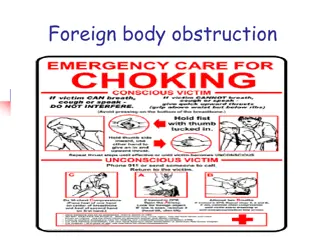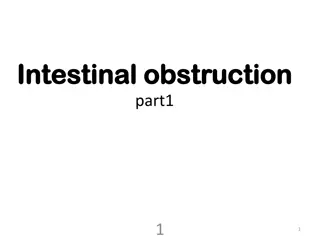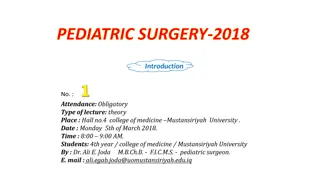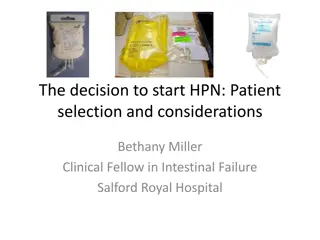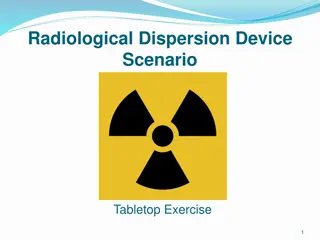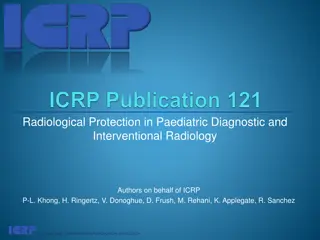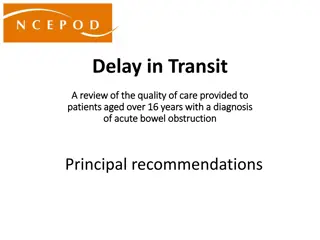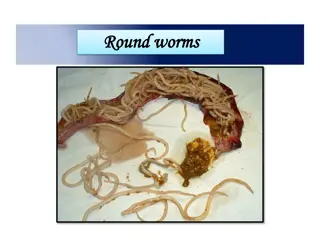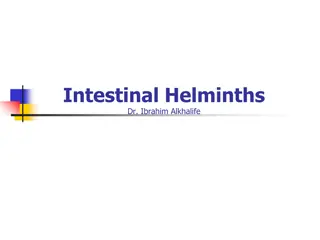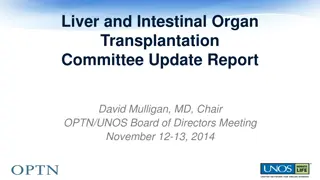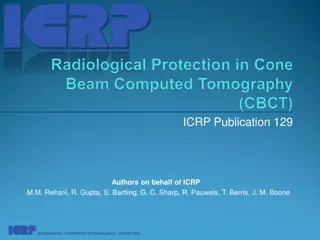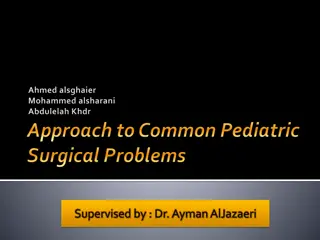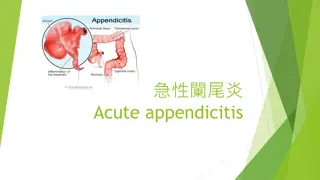Radiological Features and Clinical Presentations of Intestinal Obstruction
Intestinal obstruction can manifest with various clinical features such as sudden severe pain, tenderness, fever, and more. Imaging plays a crucial role in diagnosing obstruction, with X-rays showing characteristic findings in the small bowel and colon. Different types of obstructions like strangulation and volvulus present distinctively, requiring prompt recognition and management. Understanding the radiological features is essential in diagnosing and managing cases of intestinal obstruction efficiently.
Download Presentation

Please find below an Image/Link to download the presentation.
The content on the website is provided AS IS for your information and personal use only. It may not be sold, licensed, or shared on other websites without obtaining consent from the author.If you encounter any issues during the download, it is possible that the publisher has removed the file from their server.
You are allowed to download the files provided on this website for personal or commercial use, subject to the condition that they are used lawfully. All files are the property of their respective owners.
The content on the website is provided AS IS for your information and personal use only. It may not be sold, licensed, or shared on other websites without obtaining consent from the author.
E N D
Presentation Transcript
Intestinal obstruction 2 1
Clinical features of strangulation Sudden sever constant pain Tenderness and rigidity Fever Tachycardia Other signs of shock When strangulation occurs in an external hernia, the lump is tense, tender and irreducible and there is no expansile cough impulse. Skin changes with erythema or purplish discolouration are associated with underlying ischaemia. 2
Clinical features of volvulus Volvulus of the small intestine Usually in lower ileum Primary or secondary Caecal volvulus May occur as part of volvulus neonatorum Usually a clockwise twist. It is more common in females Present acutely The volvulus typically results in the caecum lying in the left upper quadrant 3
Sigmoid volvulus Young patients appearing to develop the more acute form Signs of acute LB obstruction with hiccough and retching In the elderly, a more chronic form may be seen. 4
IMAGING X-ray Nowadays radiological diagnosis is based on a supine abdominal film An erect film may subsequently be requested when further doubt exist. 5 5
Radiological features of obstruction (on plain x-ray) The obstructed small bowel is characterized by straight segments that are generally central and lie transversely. No/ minimal gas is seen in the colon The jejunum is characterized by its valvulae conniventes, which completely pass across the width of the bowel and are regularly spaced, giving a concertina or ladder effect Ileum the distal ileum has been piquantly described by Wangensteen as featureless Caecum a distended caecum is shown by a rounded gas shadow in the right iliac fossa Large bowel, except for the caecum, shows haustral folds, which, unlike valvulae conniventes, are spaced irregularly, do not cross the whole diameter of the bowel and do not have indentations placed opposite one another 7
In intestinal obstruction, fluid levels appear later than gas shadows as it takes time for gas and fluid to separate In adults there are 2 normal fluid levels one in the duodenal cap and the other in the terminal ileum. In children it is difficult to distinguish large from small bowel in the presence of obstruction. In the small bowel, the number of fluid levels is directly proportional to the degree of obstruction and to its site. Distal LB obstruction not associated with air fluid levels unless advanced, High colonic obstruction may do so in the presence of an incompetent ileocaecal valve. Colonic obstruction is usually associated with a large amount of gas in the caecum. 8
Water soluble contrast Is considered diagnostic, therapeutic and prognostic. Barium study is contraindicated in acute obstruction 10 10
CT SCAN Widely used nowadays as it has high accuracy in diagnosing I.O and possibly its cause. The only drawback of CT scan in diagnosis of bowel ischemia. 11
Imaging in intussusception Plain x-ray: small or large bowel obstruction A soft tissue opacity is often visible in children. absent caecal gas shadow in ileocolic cases Barium enema: It shows claw sign 13
Abdominal ultrasound It shows the typical doughnut appearance of concentric rings in transverse section. CT scan The most sensitive radiological The characteristic features of CT scan include a target - or sausage - shaped soft-tissue mass with a layering effect; mesenteric vessels within the bowel lumen 14
Imaging in volvulus Caecal volvulus: X-RAY: Caecal dilatation (98 100%), Single air-fluid level (72 88%), Small bowel dilatation (42 55%) absence of gas in distal colon (82 91% Barium enema: Absence of barium in the caecum and a bird beak deformity. CT scanning The best diagnostic choice 15 15
Sigmoid volvulus: X-ray shows coffee bean sign 18
TREATMENT OF ACUTE INTESTINAL OBSTRUCTION Treatment of acute intestinal obstruction Gastrointestinal drainage via a nasogastric tube Fluid and electrolyte replacement using Hartmann s solution or normal saline. Relief of obstruction Surgical treatment is necessary for most cases of intestinal obstruction but should be delayed until resuscitation is complete, provided there is no sign of strangulation or evidence of closed- loop obstruction. 19
Surgical treatment Indications for early surgical intervention Obstructed external hernia Clinical features suspicious of intestinal strangulation Obstruction in a virgin abdomen The classic clinical advice the sun should not both rise and set on a case of unrelieved acute intestinal obstruction. If there is no evidence of ischemia postpone surgery till resuscitation is enough. Where obstruction is likely to be secondary to adhesions, conservative management may be continued for up to 72 hours in the hope of spontaneous resolution. 20 20
Principles of surgery (small bowel): Midline laparotomy incision deliver the distended small bowel into the wound to have access into the cause of obstruction Operative decompression by either: 1. Large orogastric tube with gentle milking of SB content into the stomach 2. Savage s decompressor 21
Treatment of obstruction depend on the cause Division of adhesions (enterolysis). Excision bypass or proximal decompression checking bowel viability if the bowel viability is in doubt, so; wrapped in hot packs for 10 minutes and increase O2 supply, then check again, if in doubt so resect (if this does not result in short bowel syndrome). 22
Differentiation between viable and non-viable intestine. Be aware of Intestinal ischaemia/reperfusion injury following reperfusion of ischaemic bowel with remote lung injury. In massive infarction, surgical resection is depending on overall general condition, so; in elderly you may leave it but in young age resect with subsequent I.V alimentation and bowel transplantation 23
When no resection has been undertaken or there are multiple ischaemic areas (mesenteric vascular occlusion), a second-look laparotomy at 24 48 hours may be required. Small bowel obstruction and strangulation occur in relation to port site hernias in laparoscopic surgery. 24
Treatment of adhesions Supportive measures (conservative) usually curative Close monitoring to exclude development of strangulation and ischemia If obstruction is not relieved in 24 hours, proceed to surgery, even if you find multiple adhesions, only one is the cause of obstruction, if it really caused by multiple adhesions so sharply dissect all. Laparoscopic adhesiolysis in the hands of advanced laparoscopic practitioners. In recurrent cases follow the same principles above 25 25
Postoperative intestinal obstruction Early fibrinous postoperative intestinal obstruction is difficult to be differentiated from persistent paralytic ileus, but it usually suspected in a patient who s bowel function has returned then he develop the obstruction. Obstruction is usually incomplete and the majority settles with continued conservative management. Could be diagnosed by CT scan if there was a septic cause (collection). 26
TREATMENT OF ACUTE LARGE BOWEL OBSTRUCTION It depend on the 1. Cause of obstruction for example diverticular disease, malignancy and wether it s curable or not 2. Patient general condition Surgical options: Resection and anastomosis Defunctioning stoma (ileostomy or colostomy) Resection and stoma (Paul Mikulicz procedure or Hartmann s procedure). Bypass surgery Self expanding metal stents in irresectable stenosing tumors 27
Treatment of caecal volvulus At operation the volvulus is usually found to be ischaemic and needs resection. If viable: Detwist the volvulus Decompress the caecum with needle Fix the caecum to the lateral abdominal wall (caecopexy) with or without caecostomy. Recurrence after caecopexy is 40%. 28
Treatment of sigmoid volvulus Flexible or rigid sigmoidoscopy and insertion of a flatus tube should be carried out to allow deflation of the gut. The tube should be secured in place with tape for 24 hours and a repeat x-ray taken to ensure that decompression has occurred. In young patients, an elective sigmoid colectomy is required, the options after resection: Anastomosis, if possible. Paul- Mikulicz or Hartmann s procedure. No further treatment following successful endoscopic decompression is needed in the elderly as there is high mortality rate. 29
In recurrent volvulus in elderly, the options are resection or two-point fixation with combined endoscopic/ percutaneous tube insertion. When the bowel is viable, fixation of the sigmoid colon to the posterior abdominal wall may be a safer manoeuvre in inexperienced hands. 30 30
CHRONIC LARGE BOWEL OBSTRUCTION The causes of obstruction may be Organic: Intraluminal (rare) faecal impaction; Intrinsic intramural strictures (Crohn s disease, ischaemia, diverticular), anastomotic stenosis; Extrinsic intramural (rare) metastatic deposits (ovarian), endometriosis, stomal stenosis; 31
Functional: Hirschsprung s disease, idiopathic megacolon, pseudoobstruction. In functional cases, the symptoms may have been present for months or years. Constipation appears first. It is initially relative and then absolute, associated with distension. Maximum distention in the caecum (RIF) Pain follows Lastly vomiting 32
ADYNAMIC OBSTRUCTION Paralytic ileus Definition: failure of transmission of peristaltic waves secondary to neuromuscular failure (i.e. in the myenteric (Auerbach s) and submucous (Meissner s) plexuses). Varieties The following varieties are recognised: Postoperative: a degree of ileus usually occurs after any abdominal procedure and is self-limiting, with a variable duration of 24 72 hours. Postoperative ileus may be prolonged in the presence of hypoproteinaemia or metabolic abnormality (see below). Infection: intra-abdominal sepsis may give rise to localised or generalised ileus. 33
Reflex ileus: this may occur following fractures of the spine or ribs, retroperitoneal haemorrhage or even the application of a plaster jacket Metabolic: uraemia and hypokalaemia are the most common contributory factors. 34
Clinical features Paralytic ileus takes on a clinical significance if, 72 hours after laparotomy: there has been no return of bowel sounds on auscultation; there has been no passage of flatus. So the patient present with distention, non colicky pain (pain from the wound from distention), vomiting and negative bowel sounds (silent abdomen). X-ray shows distended SB and multiple air fluid levels. 35 35
Treatment: NG tube Restriction of oral intake until bowel sounds and the passage of flatus return. Maintaining Electrolyte balance Use of enhanced recovery programme with early introduction of fluids and solids. 5. Specific treatment is directed towards the cause, but the following general principles apply: 36
If a primary cause is identified this must be treated. Gastrointestinal distension must be relieved by decompression. Close attention to fluid and electrolyte balance is essential. There is no convincing evidence for the use of prokinetic drugs to treat postoperative adynamic ileus. if paralytic ileus is prolonged CT scanning is the most effective investigation; it will demonstrate any intraabdominal sepsis or mechanical obstruction and therefore guide any requirement for laparotomy. 37
The indications for surgery in paralytic ileus are: if it lasts for more than seven days if bowel activity recommences following surgery and then stops again. . 38
Pseudo-obstruction An obstruction, usually of the colon, that occurs in the absence of a mechanical cause or acute Intra-abdominal disease, it s a peristalsis with non propulsive manner, so there is a sluggish bowel sounds on auscultation . Small intestinal pseudo-obstruction Either primary (i.e. idiopathic or associated with familial visceral myopathy) Or secondary. Presents with recurrent subacute obstruction Diagnosis by exclusion of organic causes Treatment by correction of any underlying disorder, Metoclopramide and erythromycin may be of use. 39
Colonic pseudo-obstruction May be acute or a chronic form. The acute one is called Ogilvie s syndrome, presents as acute large bowel obstruction. X-ray show evidence of colonic obstruction, with marked caecal distension. Diagnosis also by exclusion of a mechanical cause by urgent colonoscopy or a single contrast water-soluble barium enema or CT. 40 40
Treatment : Correction of the underlying cause, if non useful Intravenous neostigmine (1 mg intravenously), with a further 1 mg given intravenously within a few minutes if the first dose is ineffective. (ECG monitoring is required and atropine should be available). If this is non useful then colonoscopic decompression should be performed. Caecal perforation is a serious complication of acute pseudo- obstruction It s diagnosed clinically by RIF tenderness and distention, caecal perforation is more likely if the caecal diameter is14 cm or greater. Surgery is associated with high morbidity and mortality and should be reserved for those with impending perforation when other treatments have failed or perforation has occurred 41
Rarely, an endoscopically placed tube colostomy is used as a vent for patients with a chronic unremitting condition. 42
Thank you 43


